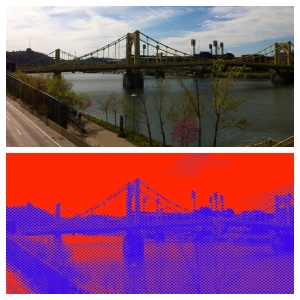Talking Back to the Art through New Technologies
by Laura Zwicker
Marketers are changing their tactics in response to the volcanic increase in mobile phone use worldwide. The powerful medium is able to reach audiences in any location, making it a desirable advertising and outreach channel. But, unlike traditional advertising, which “pushes” a message, mobile marketing works best when it “pulls” audiences in, luring them with interesting and engaging content—typically in the form of a useful application (app).

With the Warhol DIY app, developed by the Andy Warhol museum, users can go through their own digital "silkscreening" process to create Warhol-esque images.
Museums, seeking to engage new audiences – especially younger audiences, are experimenting with a variety of mobile phone apps. Among the most
interesting uses of this technology is found at The Andy Warhol Museum in Pittsburgh, where The Warhol: D.I.Y. POP app has been developed. It allows users to transform any picture in their digital photo library into an “Andy Warhol” piece of art; it engages the user with a variety of Warhol-inspired features, such as cropping, exposure and underpainting.[1] And like most successful mobile apps, The Warhol D.I.Y. POP can be used anywhere—not just within the walls of the museum. It also begs to be shared with friends, who are likely jump at the chance to download and begin converting their own photos.
The creators of the app have incorporated the interactivity that modern audiences seek, and which is also beneficial for the museum’s exposure. In addition to the interactive features mentioned already, it further presents tabs that link to more information about the museum, including opportunities to read artists’ and curators’ comments on Warhol’s work, his life, and the silkscreen process in general. Users can even enter a contest to have their “Andy Warhol-ized” image hung in the museum.
In addition, the Warhol app has an added feature that brings Andy himself into the real world. The “Layar” addition to the Warhol app:
…turns your mobile device into an augmented-reality viewer. By adding The Andy Warhol Museum Layar, you’ll be able to view locations pivotal in Andy Warhol’s life and work overlaid on real-time images from your device’s camera. View locations in Pittsburgh, PA, and New York, NY, and dive into related information and photos prepared by The Warhol’s education curators.
The Smithsonian Institution in Washington, D.C, has also introduced a variety of apps—one of which is similar to the Warhol app. The MEanderthal app allows users to “morph” pictures of themselves or friends into a prehistoric “portrait.”[2] They can share these pictures with friends in a variety of social media.
The Smithsonian’s Infinity of Nations app is similar to traditional audio guides, but offers a more in-depth experience with the art. It presents information such as the history of materials used in the pieces, extra interviews with experts, and even games.

The Infinity of Nations app allows visitors to the Smithsonian Museum of Natural History to customize their visit.
The American Museum of Natural History’s app is location-based: The Wi-Fi system in the museum triggers a real-time, 3-D map of the user’s location. The app not only offers information about the exhibits in that location, but also incorporates a personal aspect – the ability to create one’s own tour based on the current exhibits.
The useful app also offers general facts about visiting the museum. For example, information about the days and times when visitors might find shorter lines, as well as recommendations about museum “must-sees.” Best of all, users can access Twitter and Facebook thorough the app, which they can use to comment on their experience to their friends and followers. The museum’s staff can even answer questions and engage with these “digital” patrons in real time.
With today’s younger audiences seemingly wedded to their Smartphones, what better way to engage them than through these digital devices which directly engage them with the art and museum staff? Perhaps in the future, museums will introduce apps that enable patrons to comment on art, leaving their comments in the virtual world for contemplation by the next visitor to that specific, GPS-tagged spot. It’s not there yet, but might be soon. Then, full-circle conversations among patrons and museum staff will be a reality.
Ah, that’s the ticket.
_____________________
Other articles on innovative uses of technology in the arts experience, from The Muse Dialogue:
“Tweets, Texts and Tchaikovsky” by Marc Giosi
“Tactile Appreciation” by Naina Singh










Trackbacks & Pingbacks